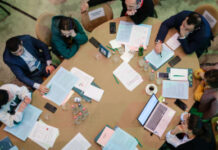By Aram Arkun
Mirror-Spectator Staff
CAMBRIDGE, Mass. — The Luys Foundation, a non-profit organization founded in 2009 in Yerevan, organized a banquet at the elegant Samberg Center of the Massachusetts Institute of Technology (MIT) on the evening of March 29 with the participation of its cofounder President Serge Sargisian and other high officials of Armenia as well as a large number of Luys scholarship recipients and alumni. The banquet program, a showcase for the foundation’s achievements, and an attempt to win further support for its work, was sponsored by the Noubar and Anna Afeyan Foundation.
The Luys Foundation offers scholarships to students of Armenian descent, including both citizens of the Republic of Armenia and diasporans, attending the top ten universities of the world as undergraduates, postgraduates or doctoral candidates. The ranking of the universities is based on the Academic Ranking of World Universities of the Center for World-Class Universities of Shanghai Jiao Tong University.
At present, Luys can grant up to ten scholarships per university, and has 420 scholars and alumni from 15 different countries. Luys Scholars mentor promising high school students in Armenia. The scholars and alumni when in Armenia conduct forums and participate in conversation series. They join or organize Armenian student associations or Luys networks wherever they may be, and host and give tours to visiting Luys peers or mentees.
Luys offers scholars and alumni various Armenian language learning tools. During summer breaks, the Luys Scholars must go to apply their skills and knowledge to community development projects in Armenia through the Develop Armenia Together project, and hopefully alumni will become leaders of Armenian society and its economy. Luys helps recruit alumni for key positions in Armenia and elsewhere in all types of fields of endeavor. It has an internship program, and provides guidance and resources for start-ups by alumni. It provides seed money ($5,000 to $20,000 per case) and planning assistance.







